For the majority, the aroma of a well-brewed coffee is enough incentive to get me out of bed in the morning. Combine that with the burst of flavors from the first sip, and I am ready to start my day. With so many different varieties of coffee to choose from, have you wondered about what is the most widespread type of coffee? Let’s find out!
Contents
What Is the Most Widespread Type of Coffee?
According to statistics, the most widespread type of coffee around the world is Arabica, which makes up 60% to 75% of the global coffee production. It is said to have originated in the southwestern highlands of Ethiopia, and the beans were exported to Arabia in the 7th century, where they were brewed for the first time to create uniquely delicious coffee.
Despite more than 100 species of coffee, Arabica is the most popular variety due to its distinctive flavor that captured the hearts and taste buds of millions of people worldwide. Moreover, the coffee has an unmistakable body and taste that earned it the title of gourmet coffee. Keep reading to find out how the coffee gets its aromatic flavors and properties. Hint: it is because of the way it is cultivated.

What Does the Arabica Coffee Plant Look Like?
Arabica coffee plant is a shrub-like plant and is known as Coffea Arabica. The plant is a self-pollinating species. This means that it maintains its characteristics unique to its species and does not mutate too much. As a result, it makes for more consistent growth and flavor.
Coffea Arabica is a flowering plant with small, white flowers with a sweet fragrance resembling jasmine flowers. The flowers appear two to four years after planting, and the plant matures at around seven years of age. Once the flowers fall, the berries grow and develop into dark red or purple coffee cherries.
The coffee beans found inside these berries are harvested by hand because the fruit ripens at different times. If you harvest fruits that are not fully ripe, it will result in a low-quality coffee with sour taste and aroma.
What Is the Growing Environment of Arabica?
Arabica coffee should ideally be grown at an elevation of over 2600 feet above sea level, typically in a subtropical climate with plenty of humidity. To thrive, the plant needs an ambient temperature of 59 to 75 degrees Fahrenheit and 39 to 59 inches of rain, evenly distributed throughout the year. The plant also prefers light shade to grow. Thus, it will not fare well in harsh climatic conditions.
What Does Arabica Coffee Taste Like?
Arabica coffee beans contain carbohydrates, amino acids, lipids, and caffeine. Each of these components reacts differently when heated during the roasting process contributing to its taste. The oils in the beans are also responsible for their robust mouthfeel after the beans are brewed. Finally, the soil where the Arabica plant grows also affects the resulting flavor of the coffee.
High-quality Arabica coffee is known for its slightly sweeter, smoother taste, with nuts, caramel, and chocolate hints. The highest quality coffee also often has hints of fruits and berries, while the acidity and bitterness are relatively milder compared to other coffee. Cold brewing can elevate the sweet flavor profile of Arabica even further.

What Are the Most Common Types of Arabica Coffee?
There are dozens of various types of Arabica coffee grown around the world. Following are the most common types:
- Typica: Typica is known for its finest quality, which makes a clean, sweet cup. It is also considered one of the first-ever varieties of Arabica discovered. The Typica plant has relatively low production and is often crossbred with other varieties to produce its distinctive taste.
- Bourbon: Bourbon is famous for its complex and balanced aroma. It was created by a natural mutation of Typica on the French Indian Ocean island of Reunion (known initially as Bourbon). It has distinguished sweetness and flavor notes of chocolate and fruits. Note: The following varieties of Arabica are all crossbred from either Typica or Bourbon.
- Caturra: Caturra coffee plant is a natural hybrid of the Bourbon plant, which was discovered growing in Brazil during the early 1900s. In the 1940s, it was introduced in Central America, where it continues to flourish today. The Caturra coffee is known for its sweet, crisp, and complex taste.
- Gesha: Gesha originates near the town of Gesha in Ethiopia, though it is now cultivated in several regions around Africa, Asia, and the Americas. The Panamanian Gesha has excellent quality and a unique, delicate taste with floral notes and a hint of honeysuckle. It is also one of the most expensive types of coffee.
- Maragogipe: Maragogipe is a natural mutation of Typica, with unusually large beans and even larger leaves that have earned the nickname “elephant bean coffee.” The plant was first discovered in Brazil, and the coffee has a heavy, buttery body with hints of citrus flavor.
What Is the Difference Between Arabica and Robusta?
Robusta coffee is the other primary species of coffee plant cultivated around the world. It accounts for up to 40% of the coffee grown globally, is relatively easier to grow, and is usually more resistant to disease and drought. Following are the difference between Arabica and Robusta:

- Arabica has a lower caffeine content as compared to Robusta. While Arabica contains 1.5% of caffeine content, Robusta has 2.7% Arabica. It contains twice the amount of sugar as Robusta, which is another trait that makes it more appealing to the masses.
- Arabica has a more pleasant flavor profile ranging from sweet and soft to sharp and tangy, depending on where it was grown. The taste has hints of chocolate, nuts, berries, and fruits. Robusta while a cheaper type of coffee bean has a more neutral and harsh taste, which is bitter and earthy.
- Robusta is easier to grow as the plant is resilient against pests, can be produced at low altitudes, and requires marginally lower production costs. Arabica coffee plants are more fragile, need a consistent climate without harsh changes and a high altitude, and are susceptible to various pests.
- Robusta is cheaper than Arabica, as it is less demanding in terms of cultivation, while Arabica is more sensitive to the environment. Arabica also produces less coffee per hectare than Robusta.
Overall, Arabica has a far superior quality than Robusta.
Related Questions
Is Starbucks Coffee Arabica or Robusta?
The famous Starbucks coffee is made from 100% Arabica coffee beans. This is because Arabica coffee is elegant, with an interesting body and acidity that can be brewed and blended into new and interesting tastes.
What Is the Difference Between Arabica and Columbian Coffee?
Columbian coffee refers to the coffee grown exclusively in Columbia and is a type of Arabica coffee. Whereas, Arabica is a generic term used to describe the coffee descended from Arabia. It is now cultivated in different parts of the world.
Conclusion
Arabica coffee is the most widely available type of coffee, followed by Robusta. It has a sweet flavor, with a slight bitterness and pleasant acidity. The Arabica coffee beans are harvested from the plant Coffea Arabica, which grows on highlands with subtropical climate under mid climatic conditions.



